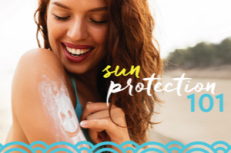Your Sunless Tanner Questions Answered
June 15, 2021

Summer is in full swing! Outdoor activities from hiking to pool-side lounging are beckoning, but a year-long pandemic might have you looking for a jump start on your healthy summer glow by using a sunless tanner. Healthy, of course, is the key here as there are many mixed claims about sunless tanners, their ingredients, and the protection they provide. Here is a quick look at the science behind a summer tan, sunless tanners, and ways to keep your skin healthy-looking throughout the season.
1. Is a tan healthy for you?
Sun care products often refer to the “healthy tan,” which creates some confusion over whether a tan is actually healthy for your skin or not. While sun exposure may help your body develop beta-endorphins and have mental health benefits, the ultraviolet radiation found in the sun’s rays is a significant factor in skin cancer.
2. Is there a safe way to get a natural tan?
More traditional tanning relies on exposing your skin to ultraviolet radiation (UVR) through sun exposure or tanning beds. UVR contributes to skin aging, wrinkles, and increased free radicals, and plays a major part in the development of skin cancer.1 Even 20 minutes in a tanning bed can increase your risk of melanoma, the most dangerous kind of skin cancer, by 20%.2

3. Does a tan protect my skin from UVR and sun damage?
No. Tans exclusively affect your skin’s coloration but provide no sun protection. It’s important to continue to use sun protection (sunscreen, shade, etc.) no matter what kind of tan you have in order to keep your skin healthy and avoid sun damage. Sun damage can increase the appearance of aging, fine lines and winkles, and skin discoloration, among others.
4. Are sunless tanners safe?
Yes. The majority of sunless tanners in the United States use an FDA approved ingredient called dihydroxyacetone (DHA) that creates a browning reaction in the uppermost layers of your skin. The reaction is limited to the epidermis (top layer of your skin) and won’t affect the more vulnerable layers under the surface.
5. What form of sunless tanner should I use?
There are many forms of sunless tanner formulas available on the market. While many formulas are a matter of preference, some also deliver more or less color and affect your application process.3 A popular option are sunless tanning lotions, which typically take a few minutes to fully react with your skin. Similar are tinted moisturizers if you just want a touch of color rather than a full tan result. Tanning sprays, mousses, and gels deliver strong color but require you blend quickly to avoid streaks and gaps. Try a few options and see which product gives you your best glow.

6. How do I get a good tan with a sunless tanner?
- Shade: Shade helps to keep your sunless tan from fading and there is no protection from the sun like physical protection. When possible, keep to the shade! Hats, long sleeves, parasols, umbrellas, etc., are all season-friendly ways of keeping your skin safe from increased UVR exposure.
- Exfoliate: Sunless tanners react with the outermost layers of your skin, which can dry out easily during summer and due to sun exposure. You want to avoid accentuating those dry patches, so best practice is to exfoliate your skin before applying a sunless tanner. This will allow for a more even application and can help extend your tan.
- Joint Areas: Your elbows, knees, and ankles tend to absorb more product than other areas of your skin, including a sunless tanner. Be sure to pay close attention to how much time you leave the product on and how much you use in these areas to help create an even tan.4
- Maintenance: Let your tan fully dry before getting dressed. Sunless tans typically last about a week before you will want to reapply. Some products are positioned to help maintain your tan (tanner wipes, for example), but your tan will fade as your skin continues its life cycle.
7. What product do we recommend?
Nu Skin’s Sunright Insta Glow is a tanner lotion that addresses issues with some of the top sunless tanners on the market. For starters, DHA can often create a chemical odor within the tanner, but Insta Glow manages to avoid a strong DHA smell. Application is also easier and more even since Insta Glow goes on evenly and smoothly and dries quickly to help avoid streaking. The instant color also allows you to blend and apply evenly rather than waiting the usual 10 minutes other lotions require for the color reaction to fully develop. It’s a great formula with great results and perfect for helping you keep a summer glow all season.
-
In the summer when the days are longer, and the sun is brighter, most people start thinking about their upcoming vacations—but few are thinking about how to protect their skin. In fact, only 34 percent of adults reported applying sunscreen with SPF 15 or higher,1 even though one-third of adults reported having a sunburn within the past year.2
-
When our skin looks good, we feel good and have more confidence. That’s why people are always on the hunt for the best products, treatments, and technology. The goal is radiant, youthful-looking, fresh-faced, and glowing skin. Luckily, it’s getting easier than ever to attain.

